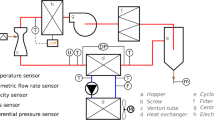Abstract
An experimental study was conducted to investigate the chronological performance variation such as pressure drop across a heat exchanger and cooling capacity due to the air-side particulate fouling of fin-and-tube heat exchangers for air conditioner evaporators used. Thirty samples of air conditioners used in the field such as inns, restaurants, and offices are collected in chronological order of use. This study was intended to provide factual long-term fouling data under actual operating conditions. It was found that the important parameters to influence the fouling of heat exchangers are the concentration and size of indoor pollutants, the filter efficiency, the hydrophilicity of fin surfaces, fin spacing, and the structure of fins. The pressure drop of heat exchangers increases from year to year due to the deposition of indoor pollutants larger than 1 Μm in size and increases up to 44% in the samples used for 7 years. Also, the air-side particulate fouling degrades the cooling capacity by 10-15% in the samples used for 7 years.
Similar content being viewed by others
References
Ahn, Y. C., Cho, J. M., Lee, J. K., Lee, H. U., Ahn, S. P., Youn, D. H., Ha, S. C. and Kang, T. W., “Performance Evaluation of the Heat Exchangers Due to Air-Side Particulate Fouling in the Air Conditioners”,Korean Journal of Air-Conditioning and Refrigeration Engineering,15(5), 447 (2003).
Bott, T. R., “Fouling of Heat Exchangers”, Elsevier, Amsterdam, Netherlands, 497 (1995).
Epstein, N., “Fouling Science and Technology-Particulate Fouling of Heat Transfer Surfaces: Mechanisms and Models”, Kluwer Academic Publishers, Dordrecht, Netherlands, 143 (1988).
Incropera, F P. and De Witt, D. P., “Fundamentals of Heat and Mass Transfer 4th ed”., John Wiley & Sons, New York, U.S.A., 568 (1996).
Korean Standard, “Air Conditioners,”, KS C 9306 (2002).
Lee, H. J., Han, D. G., Lee, S. H., Yoo, J. W., Baek, S. H. and Lee, E. K, “On-Line Monitoring and Quantitative Analysis of Biofouling in Low-Velocity Cooling Water System”,Korean J. Chem. Eng.,15(1), 71 (1998).
Lee, H. J., Park, J. S. and Moon, S. H., “A Study on Fouling Mitigation Using Pulsing Electric Fields in Electrodialysis of Lactate Containing BS A”,Korean J. Chem. Eng.,19(5), 880 (2002).
Marner, W J., MacDavid, K. S. and Muzio, L. J., “Development of a Gas Side Fouling Measuring Device”,National Heat Transfer Conference,108, 305 (1989).
Siegel, J. A., “Particulate Fouling of HVAC Heat Exchangers”, Ph. D. Thesis, University of California, Berkeley, U.S.A. (2002).
Thatcher, T. R. and Layton, D. W., “Deposition, Resuspension, and Penetration of Particles within a Residence”,Atmospheric Environment,29(13), 1487 (1995).
Author information
Authors and Affiliations
Corresponding author
Rights and permissions
About this article
Cite this article
Ahn, YC., Cho, JM., Shin, HS. et al. An experimental study of the air-side particulate fouling in fin-and-tube heat exchangers of air conditioners. Korean J. Chem. Eng. 20, 873–877 (2003). https://doi.org/10.1007/BF02697291
Received:
Accepted:
Issue Date:
DOI: https://doi.org/10.1007/BF02697291



